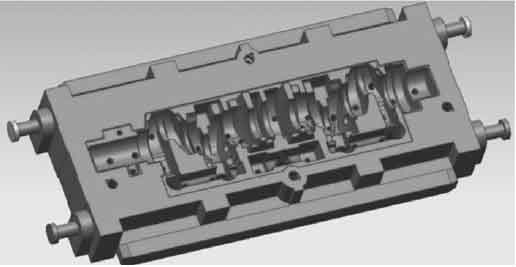In the molding process of sand coated iron mold, sand collapse and empty shell are the important reasons for sand hole defects. Through a large number of data collection and confirmation, the empty shell is mainly concentrated in the second and fifth connecting rod neck, which is easy to cause sand collapsing and fleshy in two positions; the sand covering layer around the runner is only 4-6 mm, and the gating system is 4-6 mm After long time baking and scouring of molten iron, the sand layer is more likely to produce shrinkage cracking and strength attenuation, forming sand holes, which can be demonstrated from the appearance of shot blasting of gating system. Therefore, for large castings with sand coated iron mold, sand coating layer and pouring time will become the factors affecting sand hole defects.
Optimization of sand box structure
A transverse groove is added to the shot hole at the second and fifth connecting rod neck where empty shell is easy to occur (as shown in Fig. 1) Increase the path of coated sand from perforation to the empty shell position, extend the directional curing time of coated sand, and increase the filling capacity of coated sand; in addition, chamfering is added to the cavity surface of shot hole to improve the shot pressure angle and diffusion area, improve the fluidity of coated sand and eliminate the problem of empty shell.
Thickened cross runner sand layer
When the strength of the sand layer is insufficient, the risk of sand collapse is great, which affects the quality of castings. When checking and confirming the sand covering thickness of the runner, it is found that the sand layer around the runner is only 4-6 mm, which is thinner than that of the small and medium-sized products produced normally. The high temperature shrinkage and cracking of the sand covering can easily peel off the iron sand box and wash into the molten iron, resulting in sand holes. Therefore, on the basis of increasing the cross-section along with the cross-section of the mold runner, the iron mold is treated to ensure that the sand coating thickness of the gating system is about 10-12mm (as shown in Fig. 2), the thickness of the coated sand layer is increased, the high-temperature strength is improved, and the sand hole caused by molten iron scouring is reduced.


